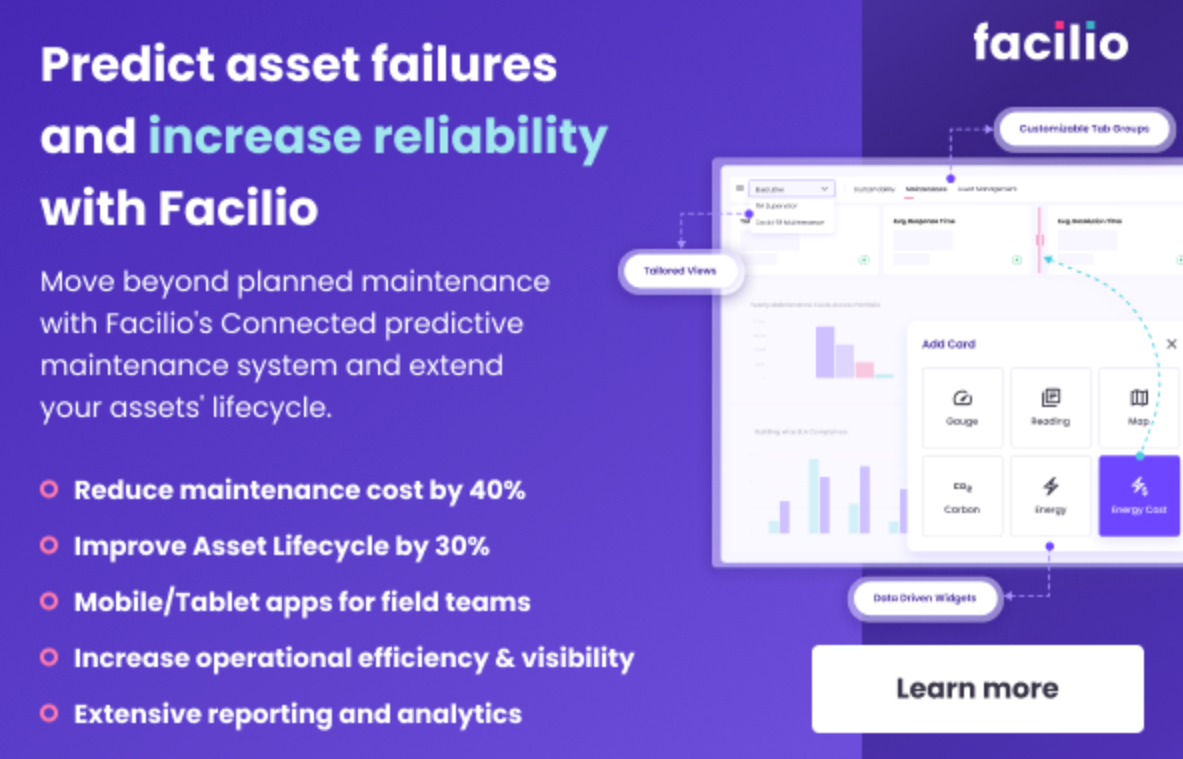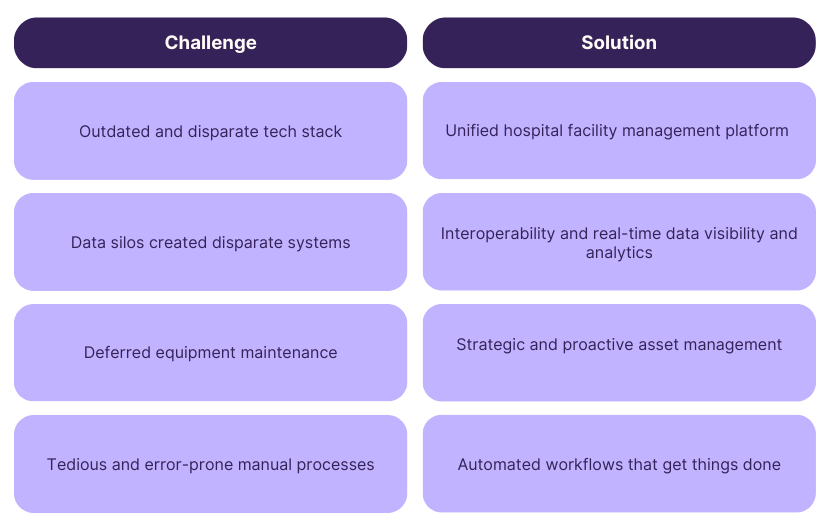How to Streamline and Manage Hospital Facility Management
The healthcare industry is evolving to keep up with the digitization trends, yet hospital facility management still lags behind, tethered to archaic methods and outdated technology.
It is similar to the struggle of attempting to navigate a modern metropolis using a centuries-old map.
In an era where technological advancement shapes industries, healthcare facilities remain an anomaly, struggling with decentralized operations and technology that lacks context.
In a survey of 200 global health system executives, 75% prioritized digital and analytics transformation but lacked the resources or planning in this area.
Legacy systems were cited as their second-greatest concern, following budget constraints.
This resistance to change has created challenges that manifest in the form of data silos, inefficiencies, and reactive maintenance, which not only strain resources and cause staffing shortages but also impede patient care.
While telehealth and telemedicine have taken center stage, hospital facilities and operations team (O&M) struggle with outdated systems, particularly in the Middle East and the UK.
As other aspects of healthcare, like telehealth and telemedicine, embrace innovation, hospital facility management must also adopt tech-driven strategies to not only survive but thrive in this new digital landscape.
Why traditional hospital facility management fails?
Traditional hospital facility management systems primarily rely on fragmented approaches to tackle the myriad challenges arising in a healthcare setting.
These systems typically operate in silos, without interconnectivity between different departments and facilities.
The hurdle with complex regulations
Hospitals navigate a labyrinth of local, state, and federal regulations, each carrying its own updates and complexities.
This tangled web of compliance is particularly burdensome for larger organizations with multiple facilities.
Non-compliance isn't just costly; it has significant legal implications.
Deferred equipment maintenance
Healthcare equipment demands regular maintenance to prevent downtime and extend longevity. Deferred maintenance leads to reactive repairs, increasing costs and causing downtime.
Trouble managing energy usage and sustainability
Healthcare facilities, operating high-power equipment 24/7, are among the highest energy consumers.
Striking a balance between energy consumption and sustainability while maintaining service standards is a continuous challenge.
Inability to ensure seamless operations and patient safety
Hospitals must be prepared for emergencies, but unexpected equipment failures and natural calamities can catch them off guard.

Effective asset management, preventive maintenance, and robust emergency plans, including backup generators, are crucial for operational continuity and patient safety.
Outdated healthcare facility management technology
Initally, computer-aider facility management (CaFM) was designed for asset management, but current healthcare facilities often use disjointed solutions, resulting in data silos and inefficiencies.
The legacy CaFM systems that several healthcare providers use happen to be an assortment of disjointed solutions, and paper-based records and Excel spreadsheets.
Inefficient vendor management
Hospitals engage various vendors for supplies, equipment servicing, and housekeeping.
Without automated vendor onboarding, compliance checks, and performance analysis, managing these vendors becomes a challenging, spreadsheet-dependent task.
These challenges collectively create stagnation in healthcare facility management. The time is ripe for a paradigm shift; technology should be perceived not just as a set of tools but as a strategic enabler of operational excellence and patient care.
Challenging the status quo: embracing technology for hospital facility management
Technology has become the problem-solver for countless modern challenges, and hospital facility management is no exception.
From staffing shortages to natural disasters, modern integrated facility management software solutions can streamline operations and improve patient care. To truly make a difference, we need a robust tech stack built around five principles:
- Ease of integration and interoperability: A hospital management system should be designed to work seamlessly with all the other systems and tools that the hospital may already be using.
- Access to real-time data and analytics: A well-functioning hospital hinges on a robust infrastructure. Real-time data allows for proactive decision-making and rapid response to equipment downtime or patient care issues.
- Ease of scalability and flexibility: A modern hospital management system should be capable of accommodating the hospital's growing needs. It should be able to handle the increasing amounts of data, users, and regulations without any limitations.
- User-centric design with a short learning curve: Patient care providers and hospital technicians have limited exposure to digital technologies and their inner workings. Complex systems and workflows can derail their everyday routine, eventually impacting the hospital’s operational efficiency.
- Assured security and compliance: Hospitals, particularly in the U.S., UK, Middle East, and EU, must comply with several healthcare regulations and standards (for example, HIPAA). These regulations ensure the careful handling of sensitive patient data and avoid legal issues.

Transformation of Healthcare Operations: How Decision-Makers Drive Control and Visibility
The role of CaFM in making healthcare facility management hassle-free
As healthcare facilities strive to modernize and streamline their operations, the adoption of Computer-Aided Facility Management (CaFM) has become essential.
These technologies offer a centralized, efficient, and resilient approach to managing complex healthcare environments.
Implementing a healthcare CaFM enables healthcare facilities to overcome traditional management challenges and drive operational excellence.
It addresses several critical challenges that hospital management is bound to face.

Strategic asset management
Facilio automates asset maintenance schedules, ensuring timely equipment upkeep and reducing the risk of unexpected failures.
This not only extends the lifespan of assets but also minimizes the incidental costs associated with reactive maintenance.
Comprehensive vendor management
Facilio helps hospitals maintain a high standard of care by allowing them to manage contracts, monitor performance, and streamline communication with various service providers in a single platform.
Workflow automation
The no-code workflow automation feature in Facilio allows hospitals to build flexible workflows with configurable rules, enabling true automation.
Real-time visibility
With real-time data monitoring, hospital management can monitor all aspects of facility operations, enabling proactive decision-making, optimizing resource use, and rapid response to critical issues.
Real-time notifications and alerts within Facilio ensure that facility managers are always kept informed about work requests, device breakdowns, or maintenance issues.
Extensive integrations
With Facilio, you can bring all your existing applications into one place.
It supports over 60 live integrations and offers an open RESTful API, facilitating seamless integration with your building automation systems (BAS).

By unifying various applications under one platform, Facilio enhances data flow, improves decision-making, and supports comprehensive facility management.
Role-based authorization
Facilio enhances security by defining role-based access restrictions, ensuring that sensitive information is protected.
This feature allows hospitals to control who has access to specific data and functionalities based on their role.

By restricting access appropriately, Facilio helps maintain data integrity, complies with regulatory requirements, and safeguards patient and operational information.
Patient satisfaction
Ensuring a positive patient experience remains paramount.
CaFM systems like Facilio help optimize critical operational aspects such as equipment uptime, inventory management, and vendor performance.
And, so, Facilio helps healthcare providers maintain an environment where patient satisfaction is consistently improved.
Compliance report generation
Generating compliance reports based on local and federal regulatory requirements can be complex, especially when managing a portfolio of hospitals.
Facilio eliminates the guesswork in compliance reporting, offering hassle-free inspection handling and reporting for various compliance guidelines, including CMS, JCC, and OSHA.
Large hospital chains can benefit immensely from using a connected healthcare CaFM like Facilio by improving operational efficiency and reducing costs.
Eurohealth Systems' (EHS) success story is proof of that.
The future of healthcare facilities management
In today's healthcare landscape, traditional facility management approaches are inadequate, hampered by outdated technologies and decentralized operations. Effective facility management necessitates a strategic shift toward integrated, tech-driven solutions.
This transformation is driven by cloud-based platforms, machine learning, and real-time data analytics, addressing key challenges such as compliance, asset management, and energy sustainability.
Facilio's cloud-based, ML-powered platform emerges as an ideal solution, providing centralized operations, seamless data integration, and real-time visibility.
Features like workflow automation, comprehensive vendor management, and efficient staff scheduling make Facilio indispensable for modern healthcare facilities.
Adopting Facilio's connected healthcare CaFM is crucial to achieving operational excellence and enhancing patient care. Embrace centralized, intelligent, and connected hospital facility management today.
Learn more about how Facilio’s Connected Healthcare CaFM can transform your healthcare facility management.
